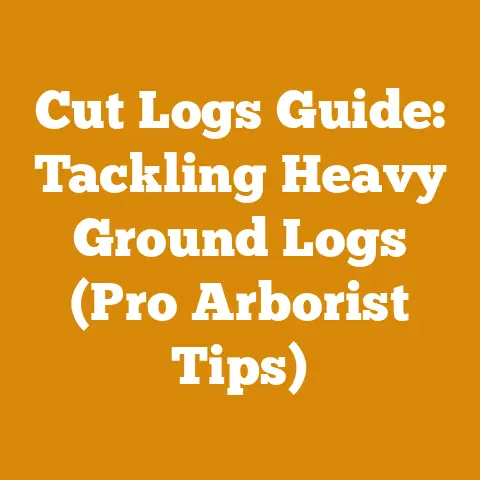John Deere 3025E Problems (5 Woodcutting Tips) to Watch For
The John Deere 3025E: A Versatile Workhorse for Wood Processing
The John Deere 3025E is a versatile compact utility tractor that’s become a staple in many wood processing and firewood preparation operations. Its size makes it maneuverable in tight spaces, while its power allows it to tackle various tasks, from moving logs to running a PTO-driven wood chipper. However, like any machine, the 3025E can experience problems. Over the years, I’ve used the 3025E extensively in my own firewood business and on various forestry projects, and I’ve learned to anticipate and address common issues that can arise, especially when working with wood.
This guide will walk you through five crucial areas to watch out for when using your John Deere 3025E for woodcutting and processing, offering practical tips and solutions based on my hands-on experience. My goal is to help you keep your tractor running smoothly, safely, and efficiently, maximizing its lifespan and productivity in your wood-related endeavors.
1. Hydraulic System Performance: Lifting Logs and Powering Implements
The hydraulic system is the lifeblood of many wood processing tasks. Whether you’re lifting logs with a grapple, operating a log splitter, or running a wood chipper, the hydraulic system is crucial. I’ve noticed that maintaining optimal hydraulic performance is vital for safe and efficient operation.
Common Issues and Troubleshooting
-
Reduced Lifting Capacity: One of the first signs of a hydraulic problem is a decrease in lifting capacity. You might find that logs you previously lifted with ease are now a struggle. This can be caused by several factors:
- Low Hydraulic Fluid Level: This is the most common cause. Always check the fluid level regularly using the dipstick, usually located near the rear of the tractor. Use the correct type of hydraulic fluid specified in your owner’s manual. I learned this the hard way when a friend topped off my reservoir with the wrong type of fluid, resulting in foamy fluid and reduced performance.
- Hydraulic Fluid Leaks: Inspect all hydraulic lines, fittings, and cylinders for leaks. Even small leaks can gradually reduce fluid levels and impact performance. Pay close attention to areas where hoses connect to cylinders or pumps.
- Clogged Hydraulic Filter: The hydraulic filter removes contaminants from the fluid. A clogged filter restricts flow and reduces pressure. Replace the filter according to the manufacturer’s recommended schedule. I typically change mine every 200 hours of operation, especially when working in dusty environments.
- Worn Hydraulic Pump: Over time, the hydraulic pump can wear out, reducing its output. This is a more serious issue that may require professional repair or replacement.
-
Slow Hydraulic Response: If your hydraulic implements are responding slowly or sluggishly, it could indicate a problem with the hydraulic system.
- Air in the System: Air can get trapped in the hydraulic system, causing erratic operation. Bleed the system according to the manufacturer’s instructions. This usually involves opening bleed screws on the hydraulic cylinders while operating the implement.
- Incorrect Hydraulic Fluid Viscosity: Using the wrong viscosity fluid can also affect performance, particularly in cold weather. Consult your owner’s manual for the recommended fluid viscosity for your operating conditions.
-
Overheating: Excessive heat can damage hydraulic components.
- Dirty Hydraulic Oil Cooler: The hydraulic oil cooler helps dissipate heat. Ensure it’s clean and free of debris. I regularly use a brush and compressed air to clean the cooler.
- Overworking the System: Avoid continuously operating the hydraulic system at its maximum capacity. Take breaks to allow the system to cool down.
Practical Tips for Maintaining Hydraulic Performance
- Regular Fluid Checks: Check the hydraulic fluid level before each use and top off as needed. This simple step can prevent many problems.
- Scheduled Filter Changes: Replace the hydraulic filter according to the manufacturer’s recommendations.
- Visual Inspections: Regularly inspect hydraulic lines, fittings, and cylinders for leaks.
- Use the Correct Fluid: Always use the type of hydraulic fluid specified in your owner’s manual.
- Avoid Overloading: Don’t exceed the tractor’s rated lifting capacity. This can damage the hydraulic system and pose a safety hazard.
- Monitor Operating Temperature: Pay attention to the hydraulic oil temperature gauge. If it’s running hotter than usual, investigate the cause.
- Professional Servicing: If you suspect a serious hydraulic problem, consult a qualified mechanic.
Case Study: Hydraulic Log Splitter Issue
I once had a situation where my PTO-driven hydraulic log splitter, powered by the 3025E, started operating very slowly. Initially, I suspected the splitter itself, but after checking the fluid levels and lines, I discovered the hydraulic filter on the tractor was completely clogged. Replacing the filter immediately restored the splitter’s performance. This experience reinforced the importance of regular filter maintenance.
2. Tire Selection and Maintenance: Traction in the Woods
Choosing the right tires and maintaining them properly is crucial for maximizing traction and stability when working in the woods. The 3025E can handle a variety of terrains, but the tires are your primary connection to the ground.
Understanding Tire Types
- R1 (Agricultural) Tires: These are the most common type of tire for agricultural tractors. They provide excellent traction in soft soil but can be aggressive on turf.
- R4 (Industrial) Tires: These tires offer a good compromise between traction and turf protection. They’re a good choice for general-purpose use.
- R3 (Turf) Tires: These tires are designed to minimize turf damage. They provide less traction than R1 or R4 tires but are suitable for mowing and light-duty tasks.
For woodcutting and processing, I typically recommend R1 or R4 tires. R1 tires offer superior traction in muddy or uneven terrain, which is common in wooded areas. R4 tires are a good option if you also need to use your tractor on lawns or other surfaces where you want to minimize damage.
Tire Pressure and Ballasting
- Tire Pressure: Maintaining the correct tire pressure is essential for optimal traction and tire life. Consult your owner’s manual for the recommended tire pressure for your specific tires and operating conditions. I always use a tire pressure gauge to ensure accurate readings. Overinflated tires reduce traction, while underinflated tires can cause premature wear and damage.
- Ballasting: Adding weight to your tractor can significantly improve traction. This is especially important when lifting heavy logs or pulling implements. Ballasting can be achieved by:
- Liquid Ballast: Filling the tires with liquid, such as calcium chloride or windshield washer fluid, is a common method of ballasting. This adds weight low to the ground, improving stability.
- Wheel Weights: Attaching cast iron weights to the wheels is another way to add ballast. This is a more expensive option than liquid ballast but allows you to easily adjust the weight as needed.
- Suitcase Weights: Attaching suitcase weights to the front of the tractor can improve stability when lifting heavy loads with the rear hitch.
I’ve found that a combination of liquid ballast in the rear tires and suitcase weights on the front provides the best traction and stability for my 3025E when working in the woods.
Tire Protection
- Sharp Objects: The woods are full of sharp objects that can puncture tires. Regularly inspect your tires for cuts, punctures, and embedded objects.
- Tire Sealant: Consider using a tire sealant to prevent flats. These sealants are injected into the tire and automatically seal small punctures.
- Tire Chains: In snowy or icy conditions, tire chains can provide significantly improved traction.
Case Study: Slipping on a Hill
I once encountered a situation where I was trying to pull a large log up a hill with my 3025E. Even with R1 tires, the tractor was struggling for traction and kept slipping. After adding suitcase weights to the front and checking the tire pressure, I was able to pull the log up the hill without any further problems. This experience highlighted the importance of proper ballasting for maximizing traction.
3. PTO (Power Take-Off) Operation: Running Wood Chippers and Splitters
The PTO is essential for powering many wood processing implements, such as wood chippers and hydraulic log splitters. Proper PTO operation and maintenance are crucial for safety and efficiency.
Understanding PTO Speeds
The 3025E typically has a 540 RPM PTO. It’s crucial to match the PTO speed of your implement to the tractor’s PTO speed to avoid damage. Operating an implement at the wrong PTO speed can cause excessive wear, vibration, and even catastrophic failure.
PTO Safety
- PTO Shield: Always ensure that the PTO shield is in place and in good condition. The PTO shield protects you from the rotating PTO shaft, which can cause serious injury if contacted.
- Clothing: Avoid wearing loose clothing or jewelry around the PTO. These can get caught in the rotating shaft and cause serious injury.
- Shut Down the Tractor: Always shut down the tractor and disengage the PTO before working on the implement or making adjustments.
- Walk Around: Before engaging the PTO, always walk around the implement to ensure that no one is in the area.
PTO Maintenance
- Greasing: Regularly grease the PTO shaft and slip clutch. This will help prevent wear and ensure smooth operation.
- Inspection: Inspect the PTO shaft and slip clutch for damage or wear. Replace any damaged parts immediately.
- Storage: When not in use, store the PTO shaft in a dry place to prevent rust and corrosion.
Operating a Wood Chipper
When operating a wood chipper with the 3025E, follow these additional safety precautions:
- Eye and Ear Protection: Always wear eye and ear protection when operating a wood chipper.
- Gloves: Wear gloves to protect your hands from splinters and debris.
- Feeding Material: Use a stick or push stick to feed material into the chipper. Never use your hands.
- Clear the Area: Keep the area around the chipper clear of debris and obstructions.
- Emergency Shut-Off: Know the location of the emergency shut-off switch.
Case Study: PTO Shaft Failure
I once witnessed a PTO shaft failure on a wood chipper being run by a similar tractor. The operator had neglected to grease the PTO shaft, and it seized up, causing the shaft to shear. Fortunately, no one was injured, but the incident could have been much worse. This experience reinforced the importance of regular PTO maintenance.
4. Engine Maintenance: Powering Through Tough Jobs
The engine is the heart of your 3025E, and proper maintenance is essential for reliable performance. When working in the woods, the engine is often subjected to heavy loads and dusty conditions, which can accelerate wear and tear.
Regular Oil Changes
Changing the engine oil and filter is the most important maintenance task you can perform. I recommend changing the oil every 100-200 hours of operation, depending on the severity of the conditions. When working in dusty environments, I change the oil more frequently.
Use the correct type of oil specified in your owner’s manual. I typically use a heavy-duty diesel engine oil.
Air Filter Maintenance
The air filter prevents dust and debris from entering the engine. A clogged air filter can reduce engine performance and fuel efficiency. Check the air filter regularly and clean or replace it as needed. I typically clean the air filter every 50 hours of operation and replace it every 200 hours.
Fuel System Maintenance
- Fuel Filter: Replace the fuel filter according to the manufacturer’s recommendations. A clogged fuel filter can restrict fuel flow and cause engine problems.
- Fuel Quality: Use high-quality fuel and avoid using fuel that has been stored for a long time. Stale fuel can cause engine problems.
- Water Separator: Drain the water separator regularly to remove water from the fuel system. Water in the fuel can cause corrosion and engine damage.
Cooling System Maintenance
- Coolant Level: Check the coolant level regularly and top off as needed.
- Coolant Condition: Inspect the coolant for signs of rust or corrosion. Replace the coolant every two years or as recommended by the manufacturer.
- Radiator: Keep the radiator clean and free of debris. A clogged radiator can cause the engine to overheat.
Starting Issues
- Battery: Ensure the battery is fully charged and in good condition.
- Glow Plugs: If your tractor has glow plugs, ensure they are functioning properly. Glow plugs help to warm the engine in cold weather.
- Fuel System: Check the fuel system for air leaks or clogs.
Case Study: Overheating in the Summer
I once had a situation where my 3025E started overheating while I was using it to haul firewood in the summer. After checking the coolant level and radiator, I discovered that the radiator was clogged with debris. Cleaning the radiator immediately solved the overheating problem. This experience highlighted the importance of keeping the cooling system clean.
5. Loader and Implements: Safe and Efficient Material Handling
The loader is an invaluable tool for moving logs, loading firewood, and performing other material handling tasks. Using the loader and implements safely and efficiently is crucial for productivity and preventing accidents.
Loader Safety
- Load Capacity: Never exceed the loader’s rated load capacity. Overloading the loader can cause damage to the tractor and pose a safety hazard.
- Stability: Be aware of the tractor’s stability when lifting heavy loads. Avoid lifting loads too high, as this can make the tractor unstable.
- Terrain: Operate the loader on level ground whenever possible. Avoid operating on steep slopes or uneven terrain.
- Attachments: Use the correct attachments for the task at hand. Ensure that the attachments are properly secured to the loader.
- Visibility: Ensure that you have good visibility when operating the loader. Use mirrors and backup cameras as needed.
- Bystanders: Keep bystanders away from the loader operating area.
Implement Selection
- Grapple: A grapple is an excellent tool for moving logs. It allows you to securely grip and lift logs without having to use chains or cables.
- Pallet Forks: Pallet forks are useful for moving pallets of firewood or other materials.
- Bucket: A bucket can be used for moving loose materials, such as gravel or soil.
- Log Splitter Attachment: A log splitter attachment allows you to split logs using the loader.
Loader Operation
- Smooth Movements: Use smooth, controlled movements when operating the loader. Avoid jerky or abrupt movements.
- Gradual Lifting: Lift loads gradually to avoid tipping the tractor.
- Lowering Loads: Lower loads slowly and carefully to avoid damaging the load or the tractor.
- Load Distribution: Distribute the load evenly in the bucket or on the pallet forks.
- Avoid Overloading: Avoid overloading the loader.
Implement Maintenance
- Greasing: Regularly grease the loader and implement pivot points. This will help prevent wear and ensure smooth operation.
- Inspection: Inspect the loader and implements for damage or wear. Replace any damaged parts immediately.
- Storage: When not in use, store the loader and implements in a dry place to prevent rust and corrosion.
Case Study: Using a Grapple for Log Removal
I once had a project where I needed to remove a large number of logs from a wooded area. Using a grapple attachment on my 3025E’s loader, I was able to quickly and efficiently move the logs to a central location for processing. The grapple significantly reduced the amount of time and effort required to complete the project. This experience highlighted the benefits of using the right attachments for the job.
In conclusion, by paying close attention to these five key areas – hydraulic system, tires, PTO, engine, and loader – you can ensure that your John Deere 3025E remains a reliable and productive workhorse for all your woodcutting and processing needs. Remember, proactive maintenance and a keen awareness of potential problems are the keys to maximizing the lifespan and performance of your tractor. Happy wood processing!






